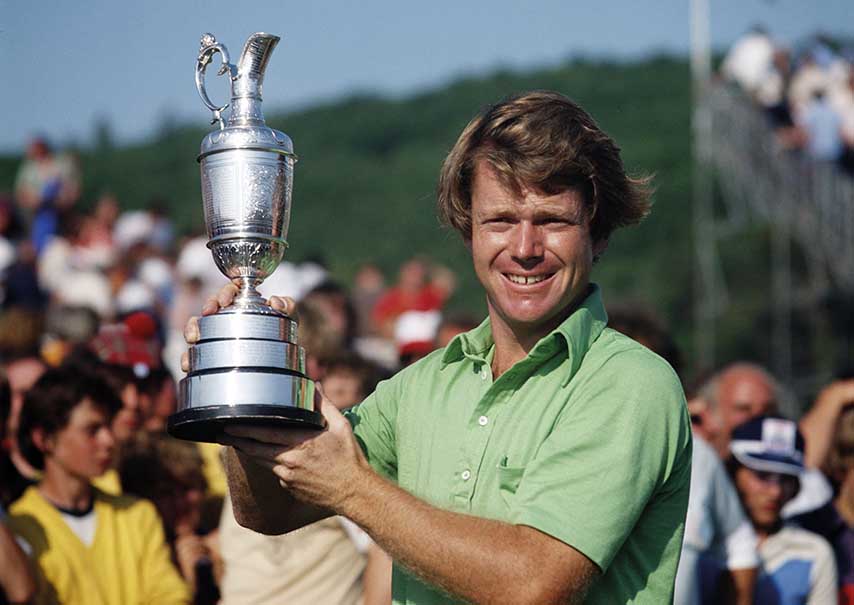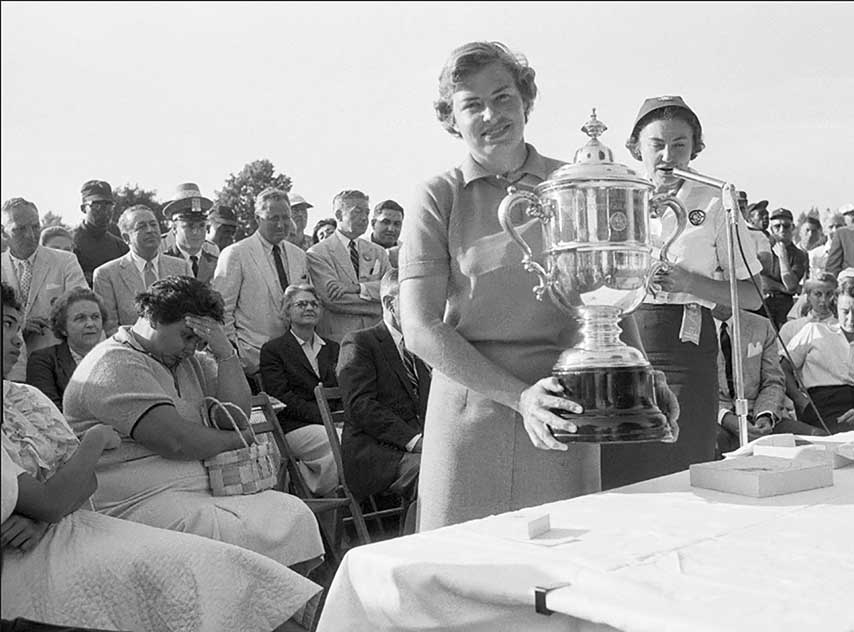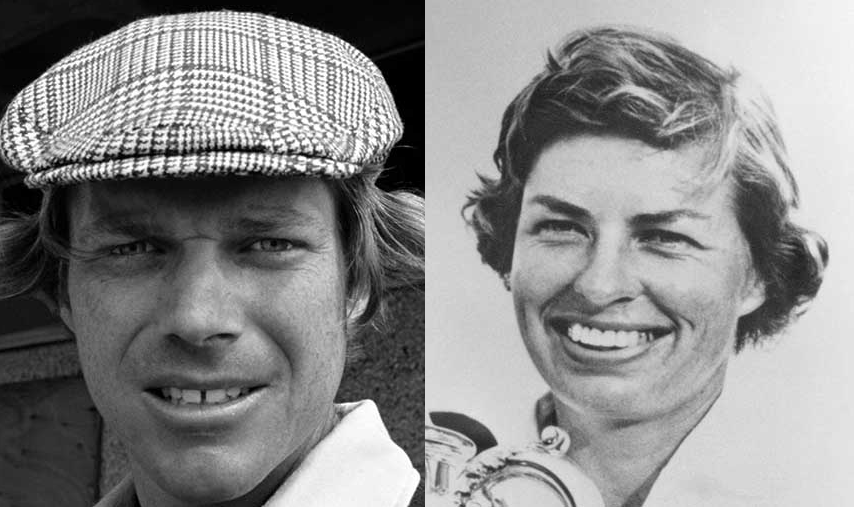With eight Grand Slam titles each, they share sixth place in the rankings of major championship winners. They are Americans Betsy Rawls and Tom Watson…
Of all the players who challenged Jack Nicklaus’ supremacy, Tom Watson carved out the greatest legacy. Watson won 39 events on the US PGA Tour, including two Masters and a US Open, and a remarkable five British Opens.
Beginning in 1977, Watson won six PGA Tour Player of the Year awards, and he led the money list five times. Yet it was his head-to-head victories against Nicklaus, 10 years his senior, that cemented him as a player for the ages.

The first came at the 1977 Masters where Watson countered Nicklaus’ fourth-round charge with four birdies on the closing six holes to win by two. Four months later, in the British Open at Turnberry, the two engaged in the most intense and highest calibre sustained battle in the history of major championship golf. Tied after 36 holes, they were paired together in the final two rounds. Nicklaus shot 65-66, only to be beaten by Watson’s 65-65.
Then, in 1982, Nicklaus, gunning for a record fifth US Open, held the lead down the stretch at Pebble Beach. Again Watson counter-attacked, finally pitching in for a birdie from deep rough off the 17th hole to produce one of the most dramatic shots ever seen. When he also birdied the 72nd hole, he had won by two strokes and earned his only US Open title.
Watson was born 4 September 1949 in Kansas City. An all-round athlete growing up, the fresh-faced but fiercely competitive Watson was nicknamed “Huckleberry Dillinger”. After a good but not spectacular junior career, Watson attended Stanford, where he graduated with a degree in psychology and showed occasional but not sustained brilliance as a golfer.
But once Watson joined the PGA Tour he showed a determination to excel that soon set him apart. “Tom would never tolerate a weakness,” said Lanny Wadkins. “He’d go to the practice tee and beat at it until the darn thing went away.”
Still, Watson had trouble winning early in his career. At the 1974 US Open at Winged Foot, he took a one-stroke lead into the final round, only to shoot a 79 that dropped him to fifth. He also led after 36 holes the next year at Medinah but again finished weakly.
Watson once said, “I learned how to win by losing and not liking it.” And he also learned from Byron Nelson, who later became his teacher and mentor.
At the British Open at Carnoustie, Watson holed a 20-footer for birdie on the 72nd hole to get into a play-off with Jack Newton and prevailed by one stroke in the 18-hole playoff. It would start a pattern of success in the oldest major that best reflected Watson’s indefatigable character as a player. Watson won the claret jug four more times, in 1977, 1980, 1982 and 1983.
“Tom takes a deep-rooted pleasure at the prospect of the challenge,” said his friend and former USGA president Frank “Sandy” Tatum. “What evolves is the focusing of an unusual intelligence on what he is setting out to do.”
Although Watson was a long hitter who had frequent streaks of superb ball striking and birdie runs, he was even better as a scrambler who could manufacture good scores with what became known as “Watson pars”.
During his reign as the best player in the game, Watson was a fearless putter who frequently ran birdie chances well by the hole, but seemingly never missed the come-backer.
After the glory years ended with his last money title in 1984, Watson’s putting declined and he won only three times. His final PGA Tour victory came in 1998.
In 1999, he began playing on the Champions Tour. Watson was Player of the Year in 2003, but the year was also marked by sadness: his long-time caddie, Bruce Edwards, was diagnosed with Lou Gehrig’s Disease. Watson co-founded an organisation, Driving 4 Life11, to fight ALS. He donated $1 million to the foundation, and during 2003 alone Watson helped raise nearly $3 million for ALS-related causes and other charities.
In 2007, Watson won his third British Senior Open. He was inducted into the World Golf Hall of Fame in 1988.
.

BETSY RAWLS
There is not a more respected woman in the game of golf than Betsy Rawls. Her 55 career victories rank behind only Kathy Whitworth, Mickey Wright and Patty Berg, and she shares the record with Wright for the most US Women’s Opens with four. But as much as what she did on the course, Rawls was admired for her excellence at every level of the game. The USGA could not have honoured a more deserving person than Rawls when it presented her with the Bob Jones Award for distinguished service in 1996. “Betsy has always been committed to work and dedicated to the game,” said Wright. “I can think of only two women who have achieved as much, not only as players but for their lifetime contributions, and that’s Betsy and Patty Berg.”
Rawls did not swing a club until she was 17. Four years later, she won the 1949 Texas Amateur and, in 1950, she finished second behind Babe Zaharias in the US Women’s Open. After graduating Phi Beta Kappa from the University of Texas, she turned professional in 1951 and won the US Open that same year.
She led the LPGA in earnings in 1952, won her second US Open in 1953 and her third in 1957. Her biggest year was 1959, when she won 10 times, including the LPGA Championship and the Western Open, and the Vare Trophy. Her biggest thrill was winning the LPGA Championship in 1969 because she had reached a point where she wasn’t sure if she could win again.
“I thought I was going to be a winner, and as I went along winning became easier and easier,” Rawls once said. “It was something I expected to do. I always played well under pressure because it didn’t bother me, which is why I won so many tournaments. I don’t take much credit for it, but I could perform under tense situations. It was my physical make-up to allow that to happen.”
When Rawls joined the Tour, there were about 20 players and 20 tournaments. She served under Zaharias as the LPGA secretary and headed the tournament committee that set up the course, gave rulings, made pairings, kept statistics and did the bookkeeping. The rest of the year was spent barnstorming for Wilson Sporting Goods with Patty Berg. They would do upwards of 120 clinics a year, travelling the country in a car.
When she retired from tournament golf in 1975, Rawls became a tournament director for the LPGA and later took over as executive director of the McDonald’s LPGA Championship. She has also served on the USGA’s rules committee and the LPGA Tournament Sponsors Association. In 1980, she became the first woman to officiate at the men’s US Open.
“Anybody who can make a living in golf is lucky,” Rawls said. “Then to receive all the benefits accorded to me in the process… well, it makes me feel fortunate. It’s more than I could possibly deserve.”




